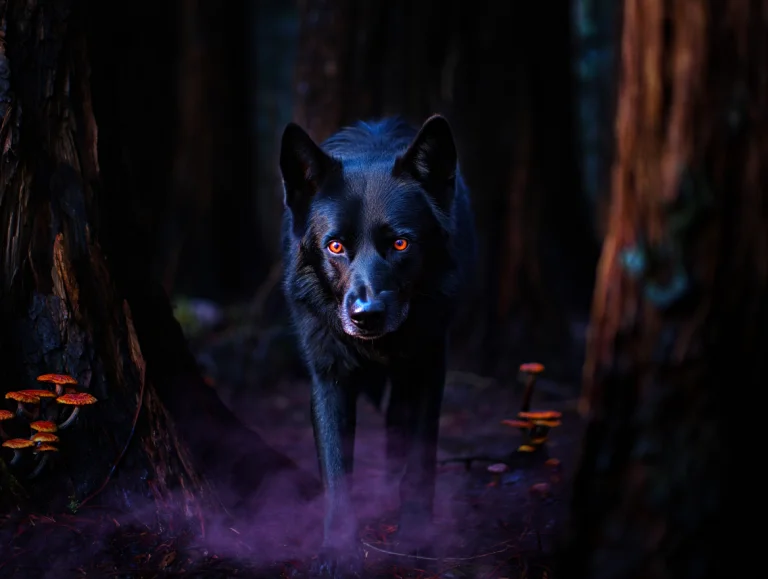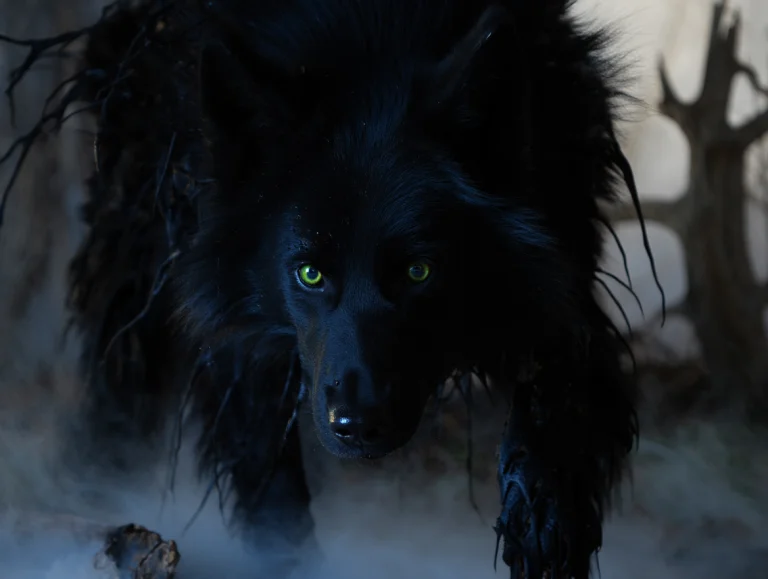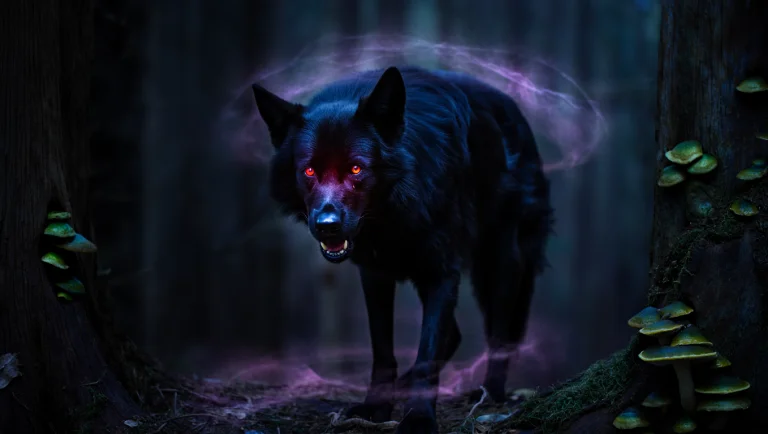Discover 5 terrifying facts about skinwalker dog , from their unnatural physical traits to unexplainable behaviors that have frightened witnesses across cultures. Learn what makes these entities so disturbing.
Table of Contents
Introduction: Understanding the Skinwalker Dog Phenomenon
The concept of a skinwalker dog has captured the imagination and fear of many across various cultures. These mysterious creatures, often described as canines with unnaturally disturbing traits and behaviors, have become a significant part of modern folklore and supernatural discussions. Stories of skinwalker dogs blend elements from Native American legends, particularly Navajo beliefs about skinwalkers, with contemporary accounts of strange canine encounters that defy conventional explanation.
In this comprehensive exploration, we’ll dive deep into five terrifying facts about skinwalker dogs that continue to fascinate and frighten people around the world. Whether you’re a folklore enthusiast, paranormal investigator, or simply curious about these eerie entities, this article will provide valuable insights into what makes these creatures so deeply unsettling to those who encounter them.
What Is a Skinwalker Dog?
Before exploring the terrifying facts, it’s essential to understand what a skinwalker dog is believed to be. In contemporary paranormal circles, a skinwalker dog refers to a canine entity that displays unnatural or impossible characteristics, suggesting it may be a traditional skinwalker (from Native American lore) that has taken the form of a dog, or a different type of supernatural entity altogether.
Traditional skinwalker beliefs originated with the Navajo (Diné) people, who describe “yee naaldlooshii” (translated roughly as “by means of it, it goes on all fours”) as evil witches who have gained the ability to transform into, possess, or disguise themselves as animals. While traditional lore includes various animal forms, modern internet culture has particularly fixated on the concept of skinwalkers appearing as dogs with disturbing, uncanny characteristics.


Fact 1: Unnatural Physical Characteristics That Defy Biology
Impossible Anatomical Features
The first and perhaps most immediately recognizable characteristic of a purported skinwalker dog is its physical appearance, which often violates normal canine anatomy in subtle but deeply disturbing ways.
Witnesses frequently report:
- Disproportionate limbs: Legs that appear too long, jointed in unnatural places, or bent at impossible angles
- Facial distortions: Muzzles that seem elongated beyond normal canine proportions or jaws that unhinge to unusual degrees
- Eye abnormalities: Eyes that reflect light incorrectly (or not at all), appear too large, too small, or positioned unnaturally on the face
- Unnatural movement patterns: The ability to move in ways that defy normal biomechanics, such as limbs bending backwards or the creature moving with an unsettling, almost mechanical precision
One particularly disturbing account from a rancher in New Mexico described seeing what initially appeared to be a stray dog crossing his property at dusk. As he approached to check if it was one of his neighbor’s animals, he noticed the dog’s legs seemed to grow longer with each step, until its proportions were clearly impossible for any natural canine.
The Uncanny Valley Effect
The concept of the “uncanny valley” helps explain why skinwalker dogs elicit such profound fear responses. Originally developed to describe human reactions to humanoid robots or animations that appear almost—but not quite—human, the uncanny valley refers to the sense of revulsion people feel when something appears very close to human but has subtle wrongness to it.
Skinwalker dogs trigger a similar response, but with canine expectations. Dogs are familiar companions to humans, and we have strong mental templates for how they should look and move. When an entity appears mostly dog-like but violates these expectations in subtle ways, it creates a deeply unsettling feeling that registers as dangerous or threatening on a primal level.
Fact 2: Behavior Patterns That Contradict Normal Canine Psychology
Intelligence Beyond Natural Capabilities
Reports of skinwalker dogs consistently highlight behaviors that suggest an intelligence far beyond that of normal canines. This unnatural cognition manifests in various ways:
- Strategic stalking: Following targets over long periods, demonstrating planning capabilities and persistence beyond normal predatory behavior
- Problem-solving: Overcoming complex obstacles or barriers in ways that suggest human-like reasoning
- Response to human speech: Reacting to spoken words or names in ways that indicate comprehension beyond simple command recognition
- Mimicry attempts: Some accounts describe these entities attempting to mimic human behaviors, such as standing on hind legs or manipulating objects with their paws
A disturbing account from a hiking group in Arizona described an encounter with what appeared to be a large, emaciated dog that followed their group for over two miles. When they attempted to lose it by crossing a fast-moving stream, they observed the creature studying the water flow, then methodically making its way upstream to find a crossing point before continuing its pursuit—displaying problem-solving abilities that suggested unsettling intelligence.
The “Hunting Awareness”
Perhaps most disturbing in behavioral accounts is what paranormal researchers have termed “hunting awareness”—the distinct sense that the entity is not merely following potential prey but is consciously aware of the psychological impact its presence has on its target.
Unlike normal predators that simply pursue prey based on instinct, skinwalker dogs are often reported to:
- Deliberately reveal themselves just enough to cause fear
- Engage in psychological “games” with targets
- Appear to derive satisfaction from creating terror rather than simply hunting for sustenance
- Maintain eye contact in a way that communicates malevolent intelligence
This apparent awareness of their effect on humans suggests something far more sinister than a simple predator-prey relationship.
Fact 3: Association with Specific Geographical Locations and Paranormal Activity
Connection to Paranormal Hotspots
One consistent pattern in skinwalker dog sightings is their connection to locations already associated with other paranormal phenomena. This geographic correlation includes:
| Region | Paranormal Connection | Notable Skinwalker Dog Activity |
| Skinwalker Ranch, Utah | UFO sightings, cattle mutilations, electromagnetic anomalies | Multiple reports of impossible canine entities stalking the property’s perimeter |
| Four Corners Region (Southwest USA) | Traditional territory for skinwalker legends | Highest concentration of contemporary skinwalker dog encounters |
| Pacific Northwest | Sasquatch sightings, unexplained disappearances | Increasing reports of unnatural canine entities in remote forests |
| Appalachian Mountains | Historical folklore entities, unexplained lights | Clusters of reports near abandoned mining operations |
| Central European forests | Historical werewolf lore | Similar entities reported using different cultural frameworks |
The concentration of sightings in these paranormally active regions has led some researchers to theorize that skinwalker dogs may be manifestations of the same energies or phenomena that cause other unexplained events in these areas, rather than discrete entities themselves.
Territorial Behavior
Unlike normal wildlife that may roam widely for food or mates, skinwalker dogs often display strong territorial behavior focused on specific boundaries:
- Many accounts describe these entities preventing people from entering certain areas
- They often appear at boundaries or thresholds (property lines, forest edges, crossroads)
- Some researchers have noted correlations between sighting locations and historical trauma sites, sacred grounds, or areas with unusual geological or electromagnetic properties
A particularly notable case involved a family in rural Colorado who reported a strange dog-like creature that would appear every evening at exactly the same point along their property line. Local research later revealed this line corresponded exactly with the boundary of an old burial ground that had been disturbed during construction decades earlier.

Fact 4: The Sound Phenomenon – Vocalizations That Defy Natural Explanation
Unnatural Acoustic Properties
One of the most consistently reported and disturbing aspects of skinwalker dog encounters involves their vocalizations. Unlike normal canine sounds (barking, growling, whining), these entities produce sounds that witnesses describe as:
- Mimicry of human speech: Attempting to form words or names, particularly of potential victims
- Impossible harmonics: Producing multiple tones simultaneously that no biological creature should be capable of
- Directional confusion: Sounds that seem to come from everywhere at once, or from directions that contradict the entity’s visible location
- Emotional manipulation: Vocalizations that trigger specific emotional responses, often extreme fear or paralysis
Audio analysts who have examined recordings of purported skinwalker dog sounds note that many contain infrasonic elements—sound frequencies below human hearing that nevertheless can cause physiological fear responses. Some theorize this may explain the intense dread witnesses report even before visually identifying the entity.
The “Name Caller” Phenomenon
A particularly chilling recurring element in accounts involves what paranormal researchers term the “name caller” phenomenon. Multiple unrelated witnesses describe hearing their names called by what sounds like a familiar voice, only to find a skinwalker dog when they investigate.
In a well-documented case from northern Arizona, a woman reported hearing what sounded exactly like her husband calling for help from their backyard. When she opened the door, she found not her husband (who was away on business) but a large, abnormally proportioned dog-like creature staring at her from just beyond the porch light’s reach. Her husband later confirmed he had been hundreds of miles away at the time.
Fact 5: The Photographic Anomaly – Visual Evidence Distortions
Camera Malfunctions and Evidence Distortion
In the age of smartphones, one might expect clear photographic evidence of skinwalker dogs to be more common. However, a frustrating and unsettling pattern has emerged regarding attempts to document these entities:
- Electronic malfunctions: Cameras, phones, and recording equipment frequently fail when attempting to capture these entities
- Battery drainage: Devices often experience sudden, complete power loss in proximity to sightings
- Image corruption: When photos are successfully taken, they often show significant digital artifacts, blurring, or distortion specifically around the entity
- Post-capture disappearance: Images that initially appear to show the entity clearly often degrade over time or disappear entirely from storage media
These technical issues have led some researchers to theorize that skinwalker dogs may emit electromagnetic interference or exist partially outside conventional physical reality, making them difficult to capture with technology designed to record normal light spectrum.
The “Different in Photos” Effect
Perhaps the most unsettling photographic anomaly is what paranormal investigators call the “different in photos” effect. In cases where images are successfully captured, witnesses often report that the photographs show something significantly different from what they observed with their own eyes.
Common discrepancies include:
- The entity appearing as a normal dog in photos despite witnesses seeing clearly abnormal features
- Shadow or lighting distortions that obscure key identifying features
- The appearance of additional entities in the photo that weren’t visible to witnesses
- Spatial distortions where the entity appears at different distances or positions than observed
A case study from Washington state involved a forestry worker who encountered what he described as an impossibly tall, thin dog-like creature with elongated limbs. The photo he managed to take before his phone died showed what appeared to be an ordinary, if somewhat mangy, coyote. When analyzed by photo experts, however, the image contained subtle anomalies in perspective and shadow placement that couldn’t be explained by normal optical principles.
Cultural Context: Skinwalker Dogs Across Different Traditions
While the contemporary concept of skinwalker dogs draws heavily from Navajo traditions, similar entities appear across multiple cultures worldwide, suggesting either a universal psychological archetype or a genuinely experienced phenomenon interpreted through different cultural lenses.
Cross-Cultural Comparisons
| Culture | Entity Name | Description | Similarities to Skinwalker Dog |
| Navajo | Yee Naaldlooshii | Shape-shifting witch that can take animal form | Original basis for skinwalker concept |
| Norse | Varúlfur | Wolf-like entity with human intelligence | Unnatural movement patterns and intelligence |
| Mesoamerican | Nagual | Shapeshifter that takes animal form, often at night | Similar abilities and malevolent intent |
| Eastern European | Strigoi | Souls that can possess animals, particularly dogs | Similar ability to mimic human sounds |
| Japanese | Inugami | Dog spirit that can be controlled to cause harm | Attachment to specific geographic areas |
These cross-cultural similarities have led some anthropologists to theorize that skinwalker dogs may represent either a psychological archetype related to primal human fears or actual encounters with anomalous entities that have been interpreted through different cultural frameworks throughout history.
Scientific Perspectives on Skinwalker Dog Phenomena
While mainstream science generally dismisses skinwalker dog accounts as misidentifications or hoaxes, some researchers in various fields have proposed theories that might explain at least some aspects of these encounters.
Psychological Explanations
Some psychologists suggest that skinwalker dog sightings may result from:
- Pattern recognition errors: The human brain’s tendency to perceive faces and familiar forms in ambiguous stimuli
- Stress-induced perceptual distortions: Fear or anxiety altering normal perception, particularly in low-light conditions
- Sleep paralysis with hypnopompic hallucinations: Waking dreams that incorporate cultural fears and expectations
- Mass hysteria or folie à deux: Shared delusions that spread through close communities or online forums
These explanations may account for some reports, particularly those involving single witnesses or occurring during periods of heightened community tension around supernatural beliefs.
Biological Possibilities
Some biologists and wildlife experts have proposed that some skinwalker dog accounts may represent encounters with:
- Animals with disease or deformities: Conditions like mange, rabies, or congenital deformities can dramatically alter an animal’s appearance and behavior
- Hybrid species: Coyote-wolf or dog-wolf hybrids can display unusual physical characteristics and behaviors that casual observers might find unsettling
- Previously undocumented species: While unlikely, remote regions could potentially harbor canid species or subspecies not yet cataloged by science
These explanations, however, fail to account for the more extreme reports involving impossible anatomy or paranormal characteristics.
FAQ: Common Questions About Skinwalker Dogs
Are skinwalker dogs real or just folklore?
The answer depends largely on one’s definition of “real.” As cultural and folkloric entities, skinwalker dogs undoubtedly exist as concepts that influence how people interpret unusual experiences. Whether they exist as physical entities in the conventional sense remains unproven by scientific standards. Many indigenous traditions hold that they are very real spiritual entities, while skeptics attribute accounts to misidentification of normal animals or psychological factors.
How does a dog become a skinwalker?
According to traditional Navajo beliefs, a skinwalker is not a transformed dog but rather a human witch who has gained the power to transform into or control animal forms, including dogs. Contemporary internet folklore sometimes suggests that skinwalker dogs are either possessed by these entities or are manifestations created by them rather than transformed animals.
Can skinwalker dogs enter private property?
Many accounts suggest these entities seem bound by certain rules or limitations. Some witnesses report that skinwalker dogs appear unable or unwilling to cross thresholds without invitation, similar to vampire lore. Others report that protective measures—ranging from traditional indigenous practices to modern security systems—seem effective at keeping them at bay.
What should I do if I encounter what I believe is a skinwalker dog?
While scientific evidence for these entities remains lacking, those who take the phenomenon seriously recommend:
- Avoid direct eye contact
- Do not call out to it or respond if it makes human-like sounds
- Retreat calmly to a secure location rather than running
- Document the experience as soon as possible, noting specific details about appearance and behavior
Are certain people more likely to encounter skinwalker dogs?
Some patterns in accounts suggest that people with certain characteristics may be more likely to report encounters:
- Those with indigenous heritage or connections to areas with strong skinwalker traditions
- People experiencing major life transitions or periods of psychological stress
- Individuals who have had previous paranormal experiences
- Those who spend significant time in remote natural areas, particularly at boundaries between different types of terrain
Is there any connection between skinwalker dogs and other cryptids?
Researchers have noted interesting overlaps between skinwalker dog sightings and other cryptid phenomena. They often occur in the same geographic regions, share similar characteristics of eluding clear documentation, and frequently involve similar descriptions of unnatural movement patterns and intelligence beyond what would be expected in known animals.
Living Safely in Areas with Skinwalker Dog Reports
For those living in regions with histories of skinwalker dog sightings, local traditions often suggest specific protective measures:
Physical Protections
- Maintain bright exterior lighting around property boundaries
- Install motion-activated security systems
- Keep domesticated dogs as companions and early warning systems
- Secure doors and windows, paying special attention to basement or ground-floor entry points
Traditional Protective Practices
With respect to indigenous cultural beliefs, some traditional protective measures include:
- Ash or blessed cornmeal spread around property boundaries
- Protective symbols or objects at entry points
- Avoiding speaking about these entities after dark
- Maintaining positive community relationships and spiritual practices
While skeptics may view these as superstition, anthropologists note that such practices often provide psychological comfort and community cohesion in areas where fear of supernatural threats exists.
Call-to-Action
Understanding the complex relationship between pets, wildlife, and folklore is just one aspect of responsible pet ownership. For more expert advice on pet care, training techniques, and understanding animal behavior, visit BlithePet . Our team of animal behavior experts and veterinarians provides guidance for both everyday pet concerns and more unusual situations.
Conclusion: The Enduring Mystery of Skinwalker Dogs
The skinwalker dog phenomenon represents a fascinating intersection of traditional indigenous beliefs, contemporary folklore, and unexplained experiences that continue to resist simple explanation. Whether interpreted through a supernatural, psychological, or biological lens, accounts of these entities tap into primal human fears about predators that exist at the edges of our understanding.
The five terrifying facts explored in this article—unnatural physical characteristics, intelligent behavior patterns, geographic connections to paranormal activity, impossible vocalizations, and photographic anomalies—highlight why these entities continue to fascinate and frighten people across cultures. While definitive evidence remains elusive, the consistency of reports across diverse witnesses and locations suggests something beyond simple misidentification may be at work.
As with many paranormal phenomena, the skinwalker dog may ultimately tell us more about human psychology and perception than about external reality—yet for those who have encountered these entities, the experience remains profoundly real and persistently disturbing.
We invite you to share your thoughts, experiences, or questions in the comments below. Have you or someone you know ever encountered something that defied explanation in the way these entities do? What traditional protective practices exist in your cultural background? The conversation around these mysterious entities continues to evolve with each new account and perspective.







